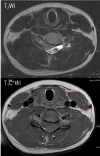Spontaneous Spinal Epidural Hematoma in a 12-Year-Old Child
- PMID: 34513360
- PMCID: PMC8412216
- DOI: 10.7759/cureus.16728
Spontaneous Spinal Epidural Hematoma in a 12-Year-Old Child
Abstract
Spontaneous spinal epidural hematoma (SSEH) is uncommon, with an estimated incidence of one per million per year in the general population. Since SSEH was first described, only 29 cases have been reported in children. This condition is difficult to diagnose and needs immediate surgical intervention for hematoma evacuation and cord decompression to obtain optimal functional and neurological outcomes. The presentation in children might be atypical. We present a case that was managed surgically and yielded full recovery.
Keywords: cervical spine; children; epidural hematoma; spinal cord injury; trauma.
Copyright © 2021, Alkhuraiji et al.
Conflict of interest statement
The authors have declared that no competing interests exist.
Figures


Similar articles
-
Spontaneous spinal epidural hematoma in children: a case report and literature review.J Spine Surg. 2024 Sep 23;10(3):606-615. doi: 10.21037/jss-24-49. Epub 2024 Aug 26. J Spine Surg. 2024. PMID: 39399075 Free PMC article.
-
Non-operative treated spontaneous spinal epidural hematoma in a 12-year-old boy.Pediatr Emerg Care. 2012 Feb;28(2):167-9. doi: 10.1097/PEC.0b013e318244785d. Pediatr Emerg Care. 2012. PMID: 22307186
-
Cervical epidural hematoma in a child.J Neurosci Rural Pract. 2012 May;3(2):217-8. doi: 10.4103/0976-3147.98259. J Neurosci Rural Pract. 2012. PMID: 22865988 Free PMC article.
-
Non-operative treatment of spontaneous spinal epidural hematomas: a review of the literature and a comparison with operative cases.Acta Neurochir (Wien). 2004 Feb;146(2):103-10. doi: 10.1007/s00701-003-0160-9. Epub 2003 Dec 5. Acta Neurochir (Wien). 2004. PMID: 14963742 Review.
-
Idiopathic and Chronic Epidural Hematoma in the Lumbar Spine: A Case Report and Review of Literatures.Neurol Med Chir (Tokyo). 2018 Mar 15;58(3):138-144. doi: 10.2176/nmc.cr.2017-0052. Epub 2018 Feb 7. Neurol Med Chir (Tokyo). 2018. PMID: 29415912 Free PMC article. Review.
References
-
- Case of spinal apoplexy. Jackson R. Lancet. 1869;94:5–6.
-
- Prognosis after spinal cord and cauda compression in spontaneous spinal epidural hematomas. Bakker NA, Veeger NJ, Vergeer RA, Groen RJ. Neurology. 2015;84:1894–1903. - PubMed
-
- Outcome after spontaneous spinal epidural hematoma in children: case report and review of the literature. Pecha M, Able A, Barber D, Willingham A. Arch Phys Med Rehabil. 1998;79:460–463. - PubMed
-
- Anterior thoracic extradural hematoma in a 5-year-old child. Epstein NE, Gilder M, Black K. Pediatr Neurosci. 1989;15:48–52. - PubMed
-
- Spontaneous spinal epidural hematoma in two toddlers: diagnostic pitfalls. Smeets N, van den Akker M, Peters B, Vanderhasselt T, Jansen A. Pediatr Dimens. 2016;1
Publication types
LinkOut - more resources
Full Text Sources
